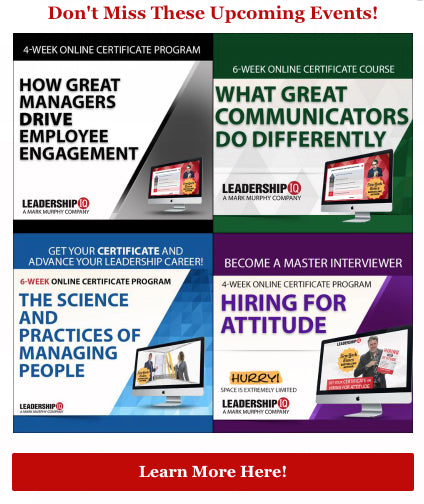5 Ways To Help Employees Overcome The Excuse Mentality
This article originally appeared on Forbes by Mark Murphy, Founder of Leadership IQ
The antidote to the excuse mentality is accountability where people take ownership, fix problems and bring solutions. Mentally and emotionally, accountability is where every leader wants their people to be. But accountability is not an either/or kind of phenomenon. Denial, blame, excuses and anxiety are all stages leading up to accountability that are part of the excuse mentality.
There’s a lot of psychology behind why people fall back on denial, blame, excuses and anxiety instead of just doing what’s asked of them. But you don’t need to climb inside your employees’ heads to bring them up to accountability. Learning where your organization and your people sit on these stages of accountability will allow you to direct and design an approach to increase the levels of employee accountability.
Here’s an overview of the four stages and what they look and sound like:
Denial is an emotional and mental state that rejects accountability with a refusal to acknowledge that there is an issue. It sounds something like this: “I don’t want to know anything so I’m just going to stick my fingers in my ears and refuse to listen.” One clue that people are stuck in denial is when you don’t hear about bad news.
Blame is when there is acceptance of an issue, but the responsibility is heaped on someone else. One clue that you’re hearing blame is the use of a proper noun: “I hear that we have a problem, but you really need to go talk to Bob in accounting (or Pat in marketing, or whomever) about this.”
Excuses are more the equivalent of the dog ate my homework and typically sound something like this: “I get that there’s an issue and I’ll even accept that it’s my issue, but I’m not totally responsible because there were mitigating circumstances… (e.g. the server went down).” People often resort to excuses out of a fear of being blamed.
Anxiety is actually close to accountability because while people may be totally freaked out, they are actually starting to take some real ownership. They might say: “I get that there’s an issue and that it’s my issue, and I’m not going to fall back on an excuse that there were mitigating circumstances. But I’m freaking out because I don’t know if I can fix this.”
So, how can you lead people out of the stages of the excuse mentality and into accountability? First of all, every time you act, ask yourself this one question: Will what I’m about to do or say help this person be more self sufficient and responsible? This lets you know if you are about to model accountability by staying focused on facts and solutions or if you are undermining your own accountability by slipping into an emotional reaction.
Second, a company culture check is in order. CYA (covering your posterior) is a common excuse response found in employees working in cultures with a “do it right the first time or else” attitude. CYA is particularly bad at spreading denial. Make sure yours is culture that encourages a “do it right the second time” attitude. This helps eliminate the fear of making mistakes so errors can become learning opportunities that inspire root cause problem solving and keep similar mistakes from happening again.
Third, the parent-child (giver-taker) dynamic that permeates the relationship between manager and employee in so many organizations fosters a sense of entitlement that keeps employees in the emotional and reactive stages of denial, blame, excuses and anxiety. Adult-to-adult dialog is required to move employees into a more logical, independent and self-sufficient path.
If denial is the issue, a calm, cool and collected discussion about facts will help eliminate defensiveness. If people are in blame, redirect the conversation to only those factors that can be controlled in the here and now. If you’re hearing excuses, eliminate the fear of blame by focusing on learning from and fixing the problem. And the best way to help someone out of anxiety is to break things into bite size chunks so they feel less overwhelmed. Help employees to feel safe coming to you with problems and mistakes by making time each month to ask questions including: Do you feel like you can come to me with a problem? What’s getting in your way? What roadblocks are you facing?
Fourth, most organizations suffer from an incomplete definition of accountability. I teach Word Pictures that use behavioral specificity to paint a vivid verbal picture of what accountability looks like broken into the three levels: “Needs Work”, “Good Work” and role-model level “Great Work”. Whatever system you use, make sure your people know exactly what accountability looks like. Use crystal clear language that helps employees develop the critical self-awareness needed to self-assess where they should focus personal improvement efforts.
Finally, if you use performance appraisals, use these meetings as an opportunity to partner with employees to harness their full potential. Employees shouldn’t feel like a student waiting to get graded by the teacher. Ask employees about their proudest moments from the year and encourage development of critical self-awareness by asking questions including: How did this month/year go? How can we build on this and make things even more effective next time?
The most accountable employees have constructive leaders who focus on fixing problems and mistakes instead of on affixing blame. Constructive leaders provide support and encouragement while allowing employees to solve and learn from problems and errors.
Mark Murphy is a NY Times bestseller, author of Hiring For Attitude, and founder of the leadership training firm Leadership IQ.







